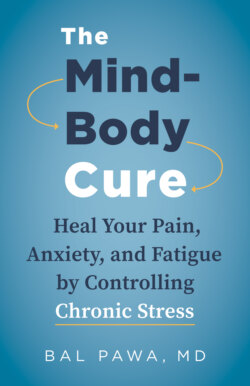Читать книгу The Mind-Body Cure - Bal Pawa - Страница 39
На сайте Литреса книга снята с продажи.
How Stress Affects Our Health
ОглавлениеAs a physician, I realize that quantifying stress is extremely difficult and requires a lot of detective work because each of us perceives stress differently. We need to look at both external (psychosocial factors) and internal (inner dialogue, unrealistic expectations, and mindset) stressors. Simply stated, some people have overt stress, which seems obvious to others, such as financial hardship, broken relationships, a demanding job, physical pain, or struggles with loneliness. Others have covert stress, which is not clear to others and sometimes not clear to themselves. They have a healthy marriage, financial security, a wonderful house, and regular vacations, yet they develop unseen stress ulcers or drop dead of a heart attack. Put another way, during prehistoric times, we regularly ran away from real-life predators like saber-toothed tigers (overt stress). Now we keep trying to run away from “internal” tigers, such as fears of rejection, loneliness, abandonment, and failure that roam our minds (covert stress). Negative thoughts and beliefs, including an illness mindset, produce a covert stress reaction in the body that has the same effect as overt stressors. So be very aware of the thoughts you think and the beliefs that run your program because they contribute greatly to your health. There could be a covert operation sabotaging your health!
We also need to look at people’s adaptive techniques or soothing behaviors to neutralize stress and understand how they were formed. Our brains are wired for social interaction; for example, newborns learn that to acquire food they must communicate and interact with people around them. They may learn that crying results in food, whereas soft cooing is a way to obtain hugging and caressing. This early conditioning primes how our brain forms the neural circuits, or thought patterns, that process information about the world and our surroundings. When love, connection, and safety are missing, human brains perceive this as a threat, which forms a neural pathway very early in development.
Emotional threats activate the gas, yet we are mostly unaware that our subconscious thoughts are producing stress hormones even without an apparent external stressor. Having mostly adverse childhood experiences sets up neural pathways for a negative inner dialogue and a lack of soothing behaviors. For example, infants can sense when there is a lack of affection, bonding, and nurturing, which can set them up to feel neglected as adults. And children who experience verbal or physical abuse and trauma are at higher risk for disease in their later years. Their neural wiring is being set early on for anxiety, worry, and a “reactive” nervous system. In contrast, infants who are held and caressed and feel love with human touch thrive better. That relationship stability in the early years helps create a sense of security and belonging that develops neural networks that are more conducive to health and fostering better relationships.
We know that stress can show up in different forms—emotional, physical, environmental toxins, infections—but the bottom line is that an endless supply of stress hormones, no matter what their source, damages our body. When we experience chronic stress, the ANS gets stuck in the gas mode and it’s like having your “pedal to the metal.” Our body was not meant to be in a perpetual stress cycle without time for recovery. Cortisol and adrenaline surge through our blood vessels, and they affect almost every tissue in the body including the brain (ironically, the same organ that triggered their production). Why? The neural pathway carrying information from the ANS overlaps with the neural pathway carrying specific memories with associated emotions from the limbic system. In other words, the brain cannot discern between real physical or emotional threats and perceived emotional ones. When excessive amounts of the chemicals that mobilize the body for an emergency circulate in the body for too long, they reinforce memories with extra strength so the body never forgets them. In effect, the stress hormones cause many changes in the brain. The neural pathway gets hijacked, and subconscious memories can cause a flood of stress hormones even when we are relaxing.
While the prefrontal cortex of our brain has become highly sophisticated, the brainstem, where many of the ANS pathways begin, has not evolved at the same pace and remains primitive. It does not discern the difference between physical threats and thoughts of anger or jealousy. It processes all these negative emotions as danger signals.
Our brain has a more negative bias than a positive one. While some animals that have escaped a near-fatal attack can literally ruffle their feathers and move on, human brains can re-create a stressful event by thought alone. Stress pathways become hardwired. We look for what is missing. We focus on the worst-case scenarios and worry about outcomes that have not happened yet. We forecast the future rather than live in the present. Worse than that, we have a rewind button that automatically replays old tapes of bad memories. This potent combination leads to ongoing surges of stress hormones. Chronic exposure to stress hormones affects the brain, both directly and indirectly.
